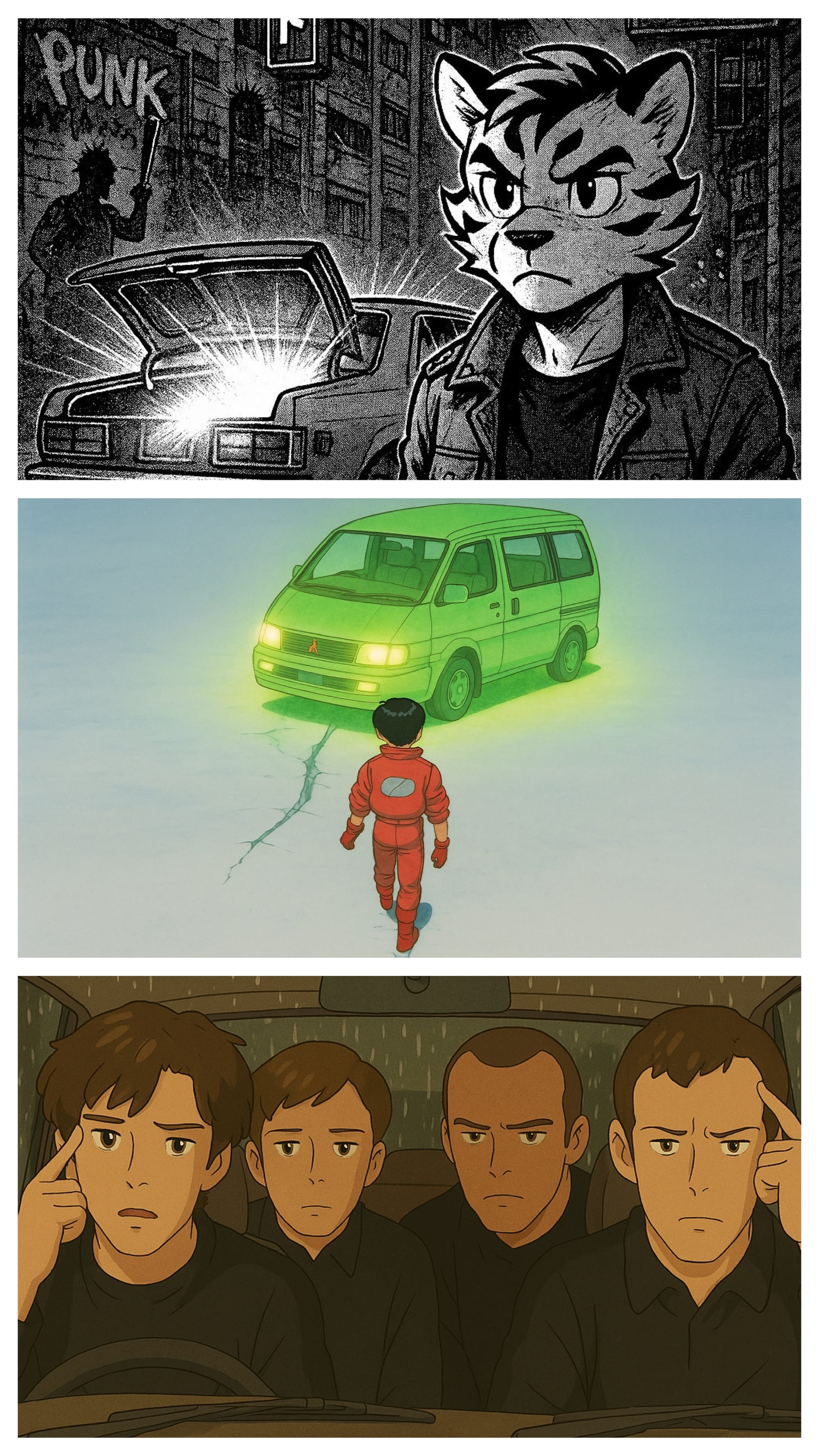TiGGR: Codex of the Repo Men
A TiGGR Retrospective
There’s always a car.
Always a job.
And always something in the back that shouldn’t be—but is.
When we published Plate of Shrimp, Neon Delica Microvan, and Cor, Blimey!, they looked like standalone zines. Different tones, timelines, genres. A punk sci-fi collapse in Los Angeles. A psychic child in a Tokyo cargo van. A slapdash crime caper in the East End.
But from the start, they were humming the same frequency.
This is the fourth ignition. The glow that links them.
This is The Repo Codex.

Three Stories, One Ritual
Each repo job was more than a setup—it was a vessel.
Each vehicle was more than a ride—it was the game’s emotional engine.
- Plate of Shrimp
A surreal Los Angeles noir where something in the trunk is warping the laws of physics, bureaucracy, and maybe the soul. The players don’t just chase the car—they chase meaning in a collapsing system. - Neon Delica Minivan
A soft-horror storybook remix of Akira, where a glowing child in a van becomes both payload and prophet. The van isn’t the escape—it’s the containment. And the players carry psychic fallout whether they want to or not. - Cor, Blimey!
A crime comedy where everyone’s plan falls apart in 30 minutes or less. The Ford Transit isn’t glowing—it’s sweating counterfeit cash and bad decisions. The real danger isn’t what’s inside, but who’s already in the pub, ready to nick it.
Three tones. Three cities. Three final decisions that feel like jokes until they land like fate.
The System Under the Hood: TiGGR
All three run on the same micro compact engine.
TiGGR isn’t just light—it’s purposefully tight.
Stats: Body, Mind, Charm.
Rolls: 2d6 + stat.
Sessions: 30–45 minutes.
Special Abilities: Once per scene.
Gear: +3 once per scenario.
Vehicle: Always a character.
Because everything’s compressed, the constraints start doing something strange: they amplify tone. When you’ve only got 5 HP and one gear bonus, every choice matters. Every burst of narrative energy surges. The game doesn’t simulate a repo job. It channels it.
And when the vehicle has 10 HP and a mind of its own?
The players start listening for the van’s voice.
Design by Drift
The Codex wasn’t written in advance. It was drifted into being.
That’s what makes it work—not just as a trilogy of settings, but as a demonstration of design through constraint. When you start with a tight rule system, the drift becomes the art. You can switch genre, location, threat, even tone—and the game still holds.
Each of these stories is a test:
- What does a punk sci-fi surrealist repo feel like?
- What if cyberpunk horror was told in watercolor?
- What if a slow-motion pub brawl was secretly a ritual of fate?
None of these settings explain themselves.
They don’t need to.
They drive themselves.
The Drift Continues
We built The Repo Codex in reverse: three loud sessions, then a whisper of recognition. A blink. A glow. A laugh. A van door slamming shut.
But you could build your own codex.
Start with a single rule.
A haunted car.
A cursed object.
A borrowed map.
And if the job feels off—keep driving.
You’re probably still in the drift.
Future Logs from the Repo Codex?
- Repo, Geist! – Berlin, 1977. You’re not driving the ambulance. It’s remembering its last patient.
- Repo, Y’all! – Appalachia, 1983. Something in the chicken truck is older than the hills.
- Repo, Mars! – Terraforming colony, 2119. The rover’s gone rogue. The payload is conscious.
Until then:
Pick a vehicle.
Pick a glow.
And whatever you do—don’t open the back.
Not yet.